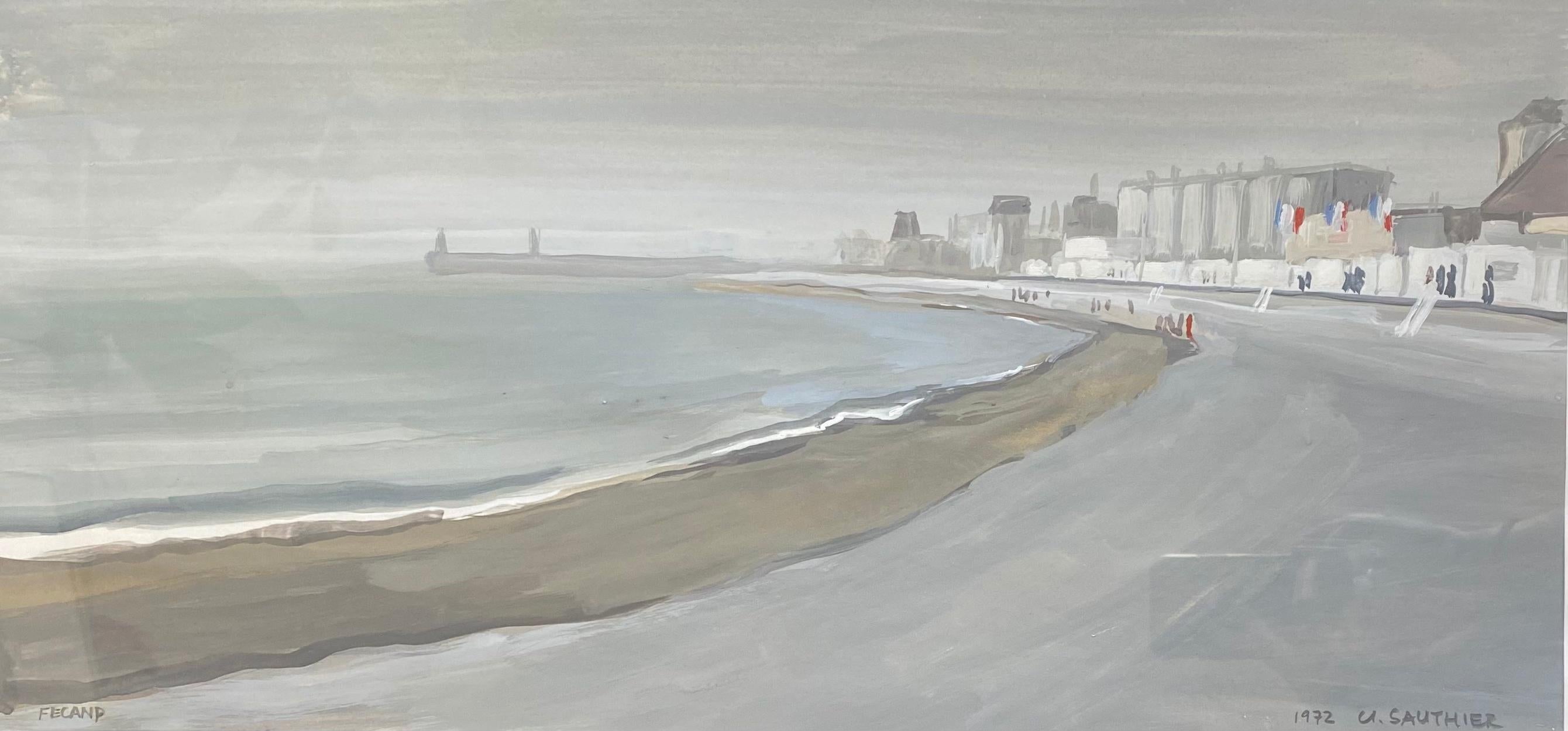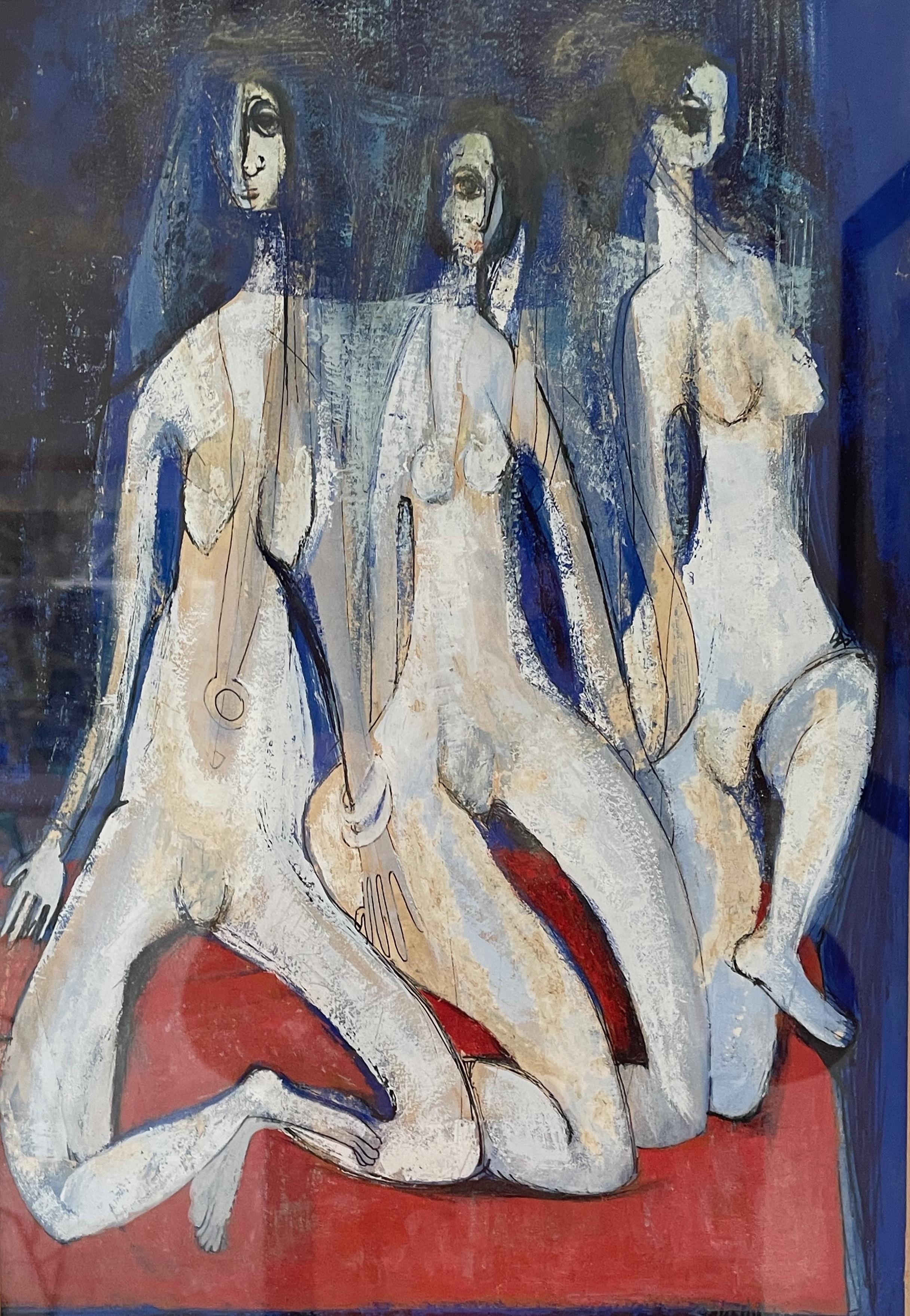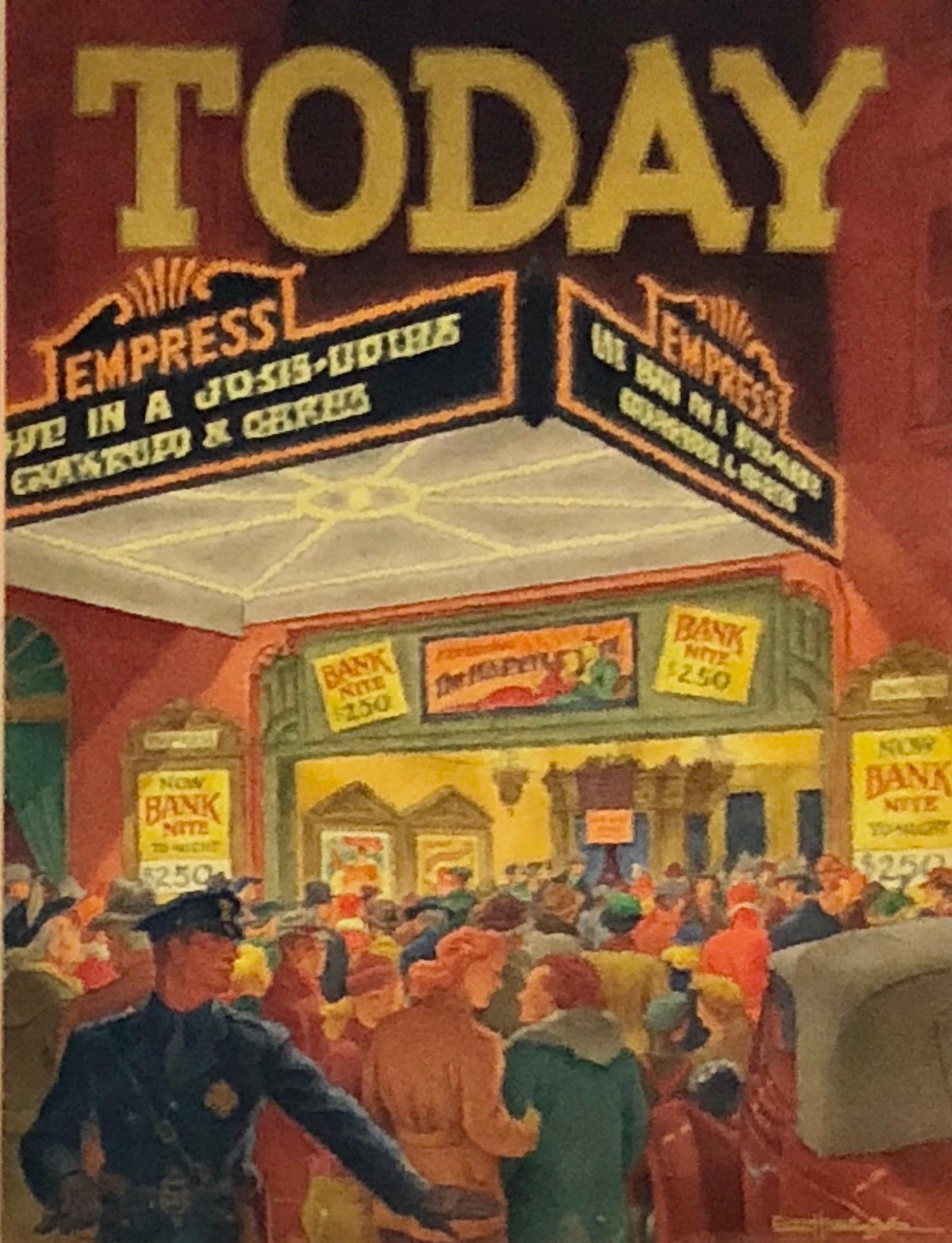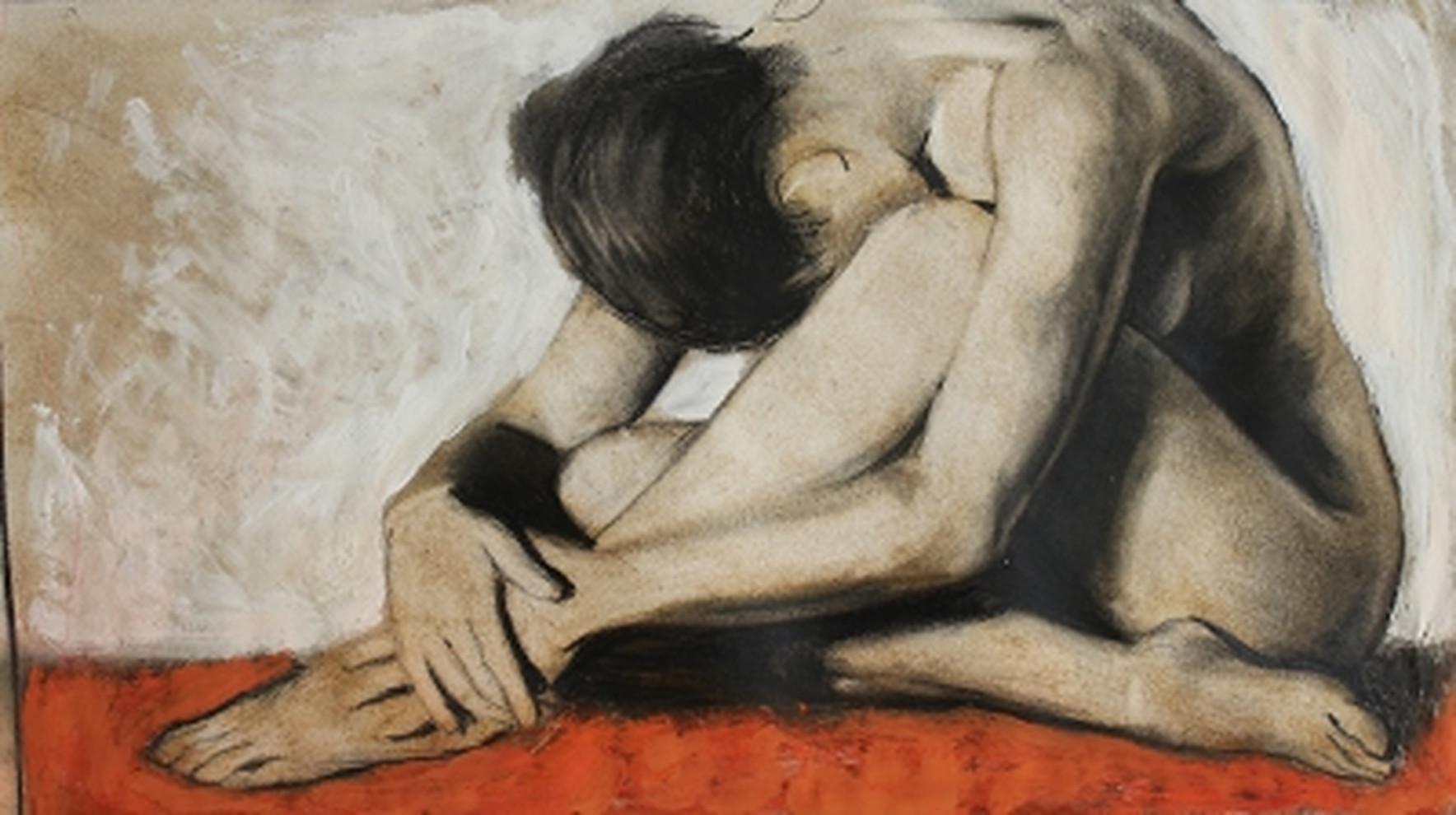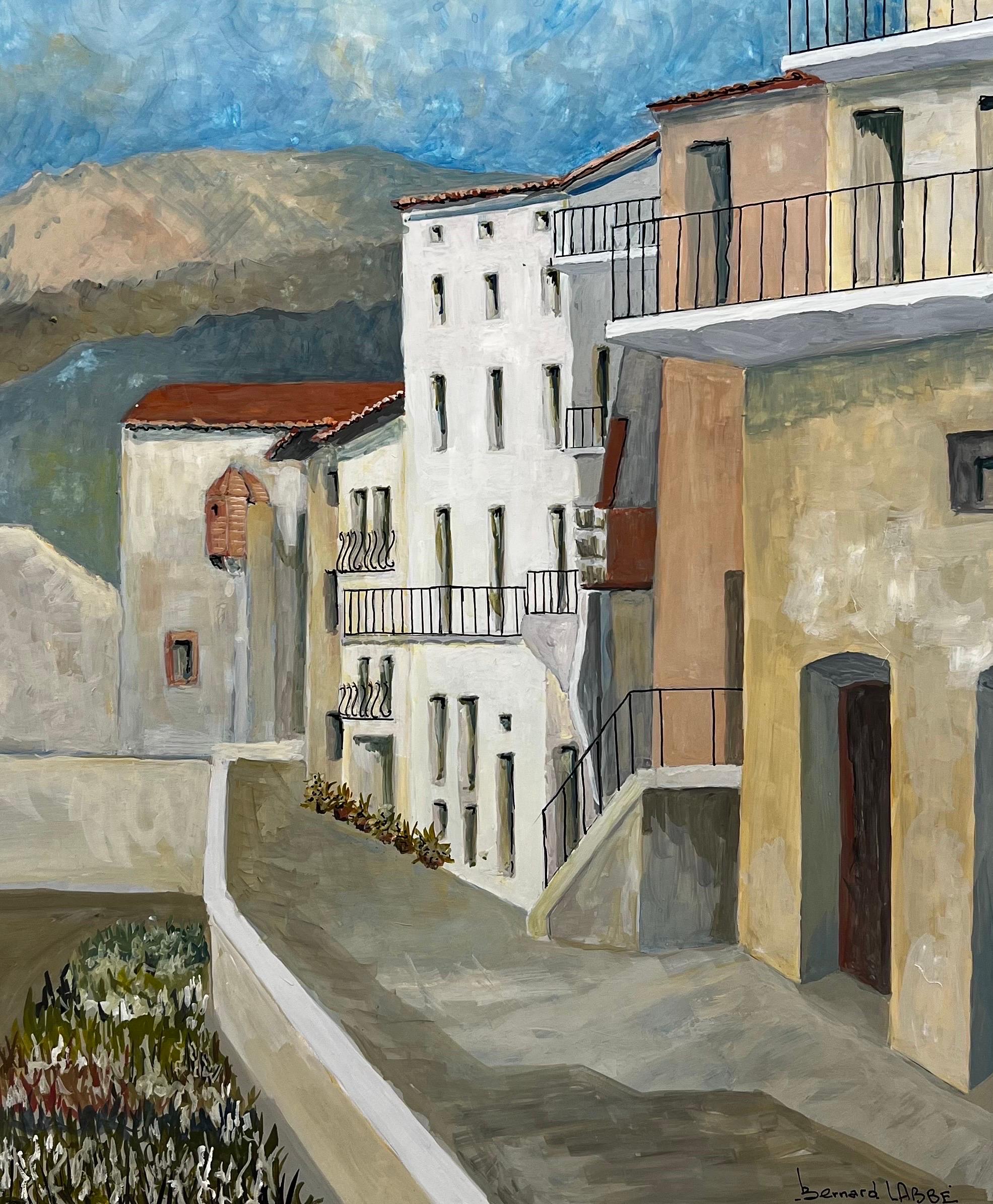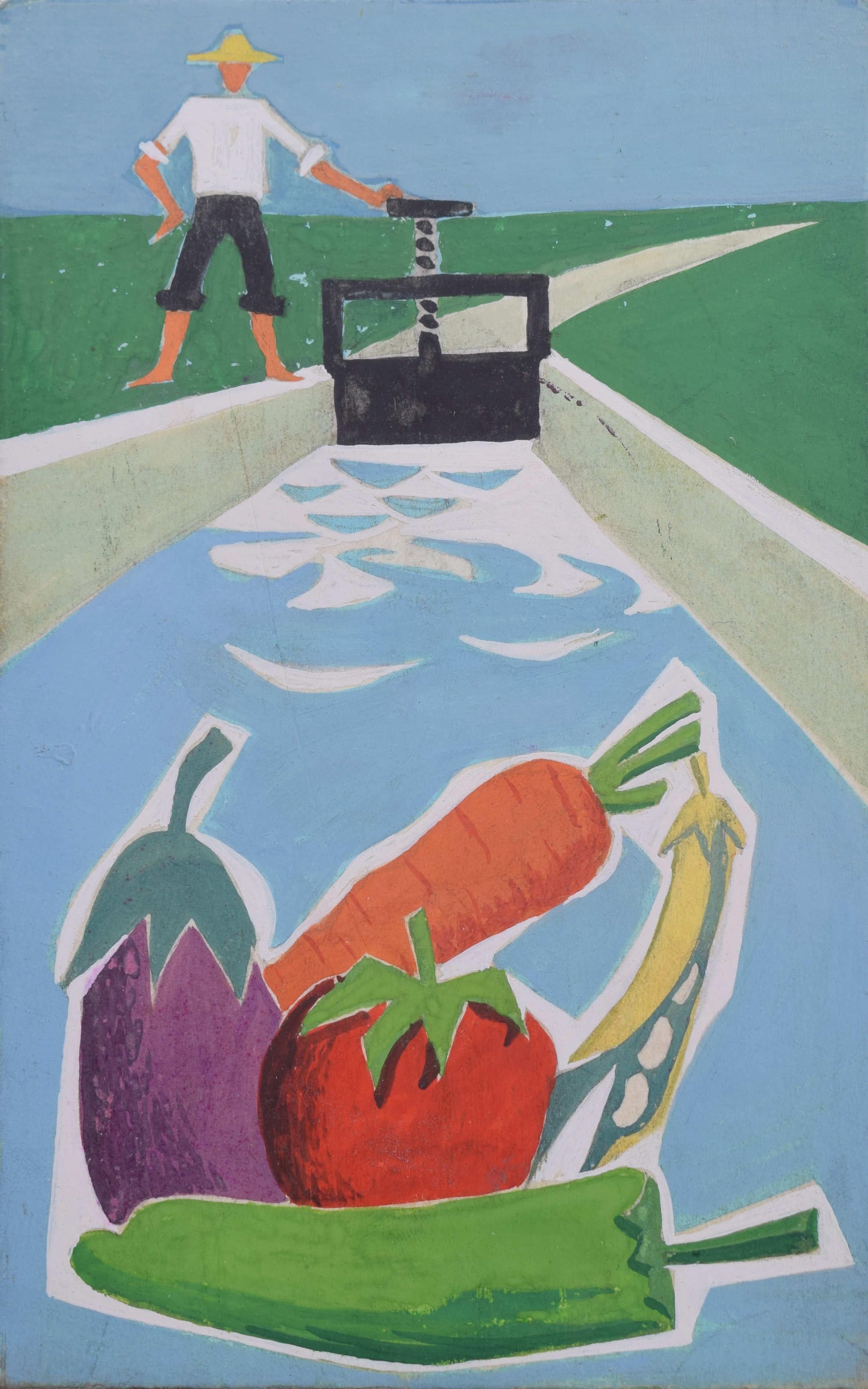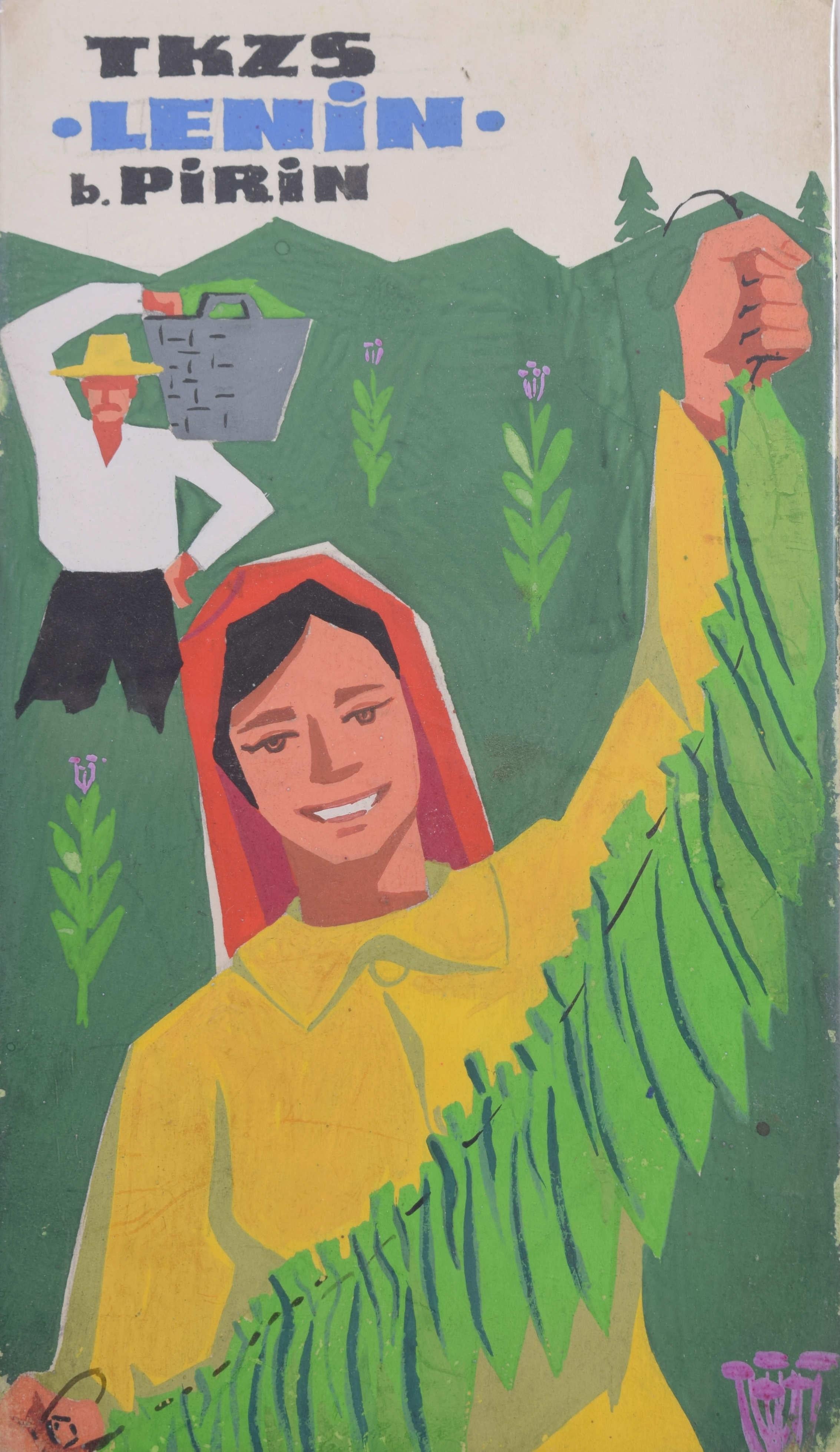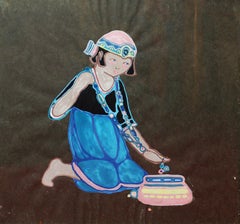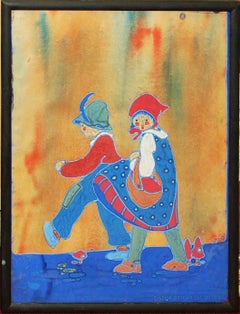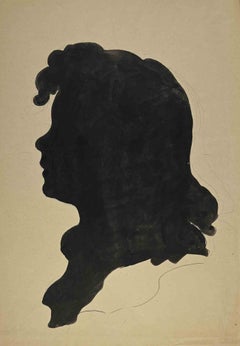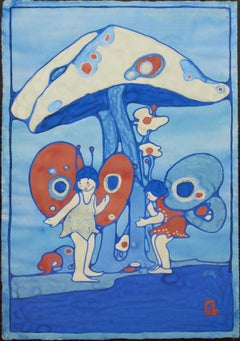
Mushroom Fairies
View Similar Items
Want more images or videos?
Request additional images or videos from the seller
1 of 5
Gisella LoefflerMushroom Fairiesc. 1919
c. 1919
About the Item
- Creator:Gisella Loeffler (1902 - 1977, American, Austrian)
- Creation Year:c. 1919
- Dimensions:Height: 21 in (53.34 cm)Width: 13.75 in (34.93 cm)Depth: 0.5 in (1.27 cm)
- Medium:
- Movement & Style:
- Period:
- Condition:
- Gallery Location:Missouri, MO
- Reference Number:1stDibs: LU74733212463
Gisella Loeffler
Born in Austria, Gisella came to the United States with her family in 1908, settling in St. Louis, MO. After studying art at Washington University in St. Louis, she became a prominent member of the local art community, joining the St. Louis Art Guild as well as the Boston Society of Arts and Crafts. In addition to creating posters for the St. Louis Post Dispatch, Gisella won prizes from the Artists Guild of the Author’s League of America in 1919 and 1920 and from the Kansas City Art Institute in 1923. She also began working in textiles, including batik, to which she would return later in her career. Having seen a local exhibition of paintings by Taos artists Oscar Berninghaus (who was from St. Louis) and Ernest Blumenschein, Gisella felt drawn to Taos, which reminded her of the villages of her native Austria. In 1933 the single mother with two daughters, Undine and Aithra, moved to Taos, where she lived off and on for the rest of her life. She traveled frequently, spending extended periods in Mexico, South America, and California, but always returned to New Mexico. Gisella initially applied an Austro-Hungarian folk-art style to the Indian and Hispanic subjects that she found in New Mexico. In her early work she covered her surfaces with decorative floral and faunal motifs, and her images were flat with no attempt at rendering traditional one-point perspective. Eventually, though, Gisella developed her own style, often using children or childlike figures as subjects. Still, the influence of her native country’s folk art remained evident in her New Mexican, Mexican, and South American images. In California, Gisella broadened her range of artistic pursuits. She taught art privately, created illustrations for Scripts Magazine, and did interior design for private homes. She also designed greeting cards, a practice she continued after her return to New Mexico, where she created a series of Christmas cards. Gisella began illustrating children’s books in 1941 when she collaborated on Franzi and Gizi with author Margery Bianco. Eventually she wrote and illustrated her own book, El Ekeko, in 1964. She also designed ceramics—her Happy Time Dinnerware, marketed by Poppy Trail and manufactured by Metlox of Manhattan Beach, CA, is highly collectible today. As a painter, she worked on canvas or paper in oil, casein, and watercolor. She also painted furniture. Besides making her own clothing, Gisella worked in other fabric arts such as batik and embroidery. In fact, she received the top award in fabric arts in 1959 and again in 1967 from the Mus-eum of International Folk Art in Santa Fe. But perhaps Gisella’s greatest legacy is the murals she painted for children’s areas in hospitals across the United States. Gisella’s death in 1977 left a large hole in the fabric of the Taos Art Colony and the entire Taos community. Yet her work, so colorful and full of joy, remains an uplifting presence in Taos.
About the Seller
5.0
Vetted Seller
These experienced sellers undergo a comprehensive evaluation by our team of in-house experts.
Established in 1970
1stDibs seller since 2017
141 sales on 1stDibs
Typical response time: 23 hours
More From This SellerView All
- The Necklace and the PotBy Gisella LoefflerLocated in Missouri, MOGisella Loeffler "The Necklace and the Pot" c. 1919 Gouache on Paper Initialed Lower Left Framed Size: approx 15 x 15 inches In a village filled with colorful characters, few Taos artists were as colorful as Gisella Loeffler [1900-1977]. From her handmade Austrian clothing and hand-painted furniture to whimsical paintings and letters written in multicolored crayon, joyful color defined the artist, who early on chose to use simply Gisella as her professional name and was known as such to everyone in Taos. In spite of her fame there—the Taos News once labeled her a Taos legend—Gisella is rarely included in scholarly discussions of the Taos Art Colony. This oversight is likely due to the naive quality of her work, in which children or childlike adults inhabit a simple, brightly colored world filled with happiness. The macabre, the sad, the tortured, the offensive—all have no place in Gisella’s paintings. Her naive style of work looks very different from that of the better-known early Taos artists. Yet both Gisella’s artwork and her interesting life command attention. Born in Austria, Gisella came to the United States with her family in 1908, settling in St. Louis, MO. After studying art at Washington University in St. Louis, she became a prominent member of the local art community, joining the St. Louis Art Guild as well as the Boston Society of Arts and Crafts. In addition to creating posters for the St. Louis Post Dispatch, Gisella won prizes from the Artists Guild of the Author’s League of America in 1919 and 1920 and from the Kansas City Art Institute in 1923. She also began working in textiles, including batik, to which she would return later in her career. In the early 1920s Gisella married writer and music critic Edgar Lacher. A difficult character, Lacher may have chafed under Gisella’s success, for the couple divorced in the 1930s. Having seen a local exhibition of paintings by Taos artists Oscar Berninghaus (who was from St. Louis) and Ernest Blumenschein, Gisella felt drawn to Taos, which reminded her of the villages of her native Austria. In 1933 the single mother with two daughters, Undine and Aithra, moved to Taos, where she lived off and on for the rest of her life. She traveled frequently, spending extended periods in Mexico, South America, and California, but always returned to New Mexico. Gisella initially applied an Austro-Hungarian folk-art style to the Indian and Hispanic subjects that she found in New Mexico. In her early work she covered her surfaces with decorative floral and faunal motifs, and her images were flat with no attempt at rendering traditional one-point perspective. Eventually, though, Gisella developed her own style, often using children or childlike figures as subjects. Still, the influence of her native country’s folk art remained evident in her New Mexican, Mexican, and South American images. In 1938 Gisella moved briefly to Los Griegos, north of Albuquerque, to be closer to medical facilities for her eldest daughter, who was suffering from rheumatic fever. Two years later, she moved to California to participate in the war effort, painting camouflage and decals on airplanes for Lockheed. In California, Gisella broadened her range of artistic pursuits. She taught art privately, created illustrations for Scripts Magazine, and did interior design for private homes. She also designed greeting cards, a practice she continued after her return to New Mexico, where she created a series of Christmas cards. Gisella began illustrating children’s books in 1941 when she collaborated on Franzi and Gizi with author Margery Bianco. Eventually she wrote and illustrated her own book, El Ekeko, in 1964. She also designed ceramics—her Happy Time Dinnerware, marketed by Poppy Trail...Category
1910s Modern Figurative Drawings and Watercolors
MaterialsGouache
Price Upon Request - Three GirlsBy Gisella LoefflerLocated in Missouri, MOGisella Loeffler "Three Girlsl" c. 1919 Gouache on Paper Initialed Lower Left Framed Size: approx 19 x 13 inches In a village filled with colorful characters, few Taos artists were as colorful as Gisella Loeffler [1900-1977]. From her handmade Austrian clothing and hand-painted furniture to whimsical paintings and letters written in multicolored crayon, joyful color defined the artist, who early on chose to use simply Gisella as her professional name and was known as such to everyone in Taos. In spite of her fame there—the Taos News once labeled her a Taos legend—Gisella is rarely included in scholarly discussions of the Taos Art Colony. This oversight is likely due to the naive quality of her work, in which children or childlike adults inhabit a simple, brightly colored world filled with happiness. The macabre, the sad, the tortured, the offensive—all have no place in Gisella’s paintings. Her naive style of work looks very different from that of the better-known early Taos artists. Yet both Gisella’s artwork and her interesting life command attention. Born in Austria, Gisella came to the United States with her family in 1908, settling in St. Louis, MO. After studying art at Washington University in St. Louis, she became a prominent member of the local art community, joining the St. Louis Art Guild as well as the Boston Society of Arts and Crafts. In addition to creating posters for the St. Louis Post Dispatch, Gisella won prizes from the Artists Guild of the Author’s League of America in 1919 and 1920 and from the Kansas City Art Institute in 1923. She also began working in textiles, including batik, to which she would return later in her career. In the early 1920s Gisella married writer and music critic Edgar Lacher. A difficult character, Lacher may have chafed under Gisella’s success, for the couple divorced in the 1930s. Having seen a local exhibition of paintings by Taos artists Oscar Berninghaus (who was from St. Louis) and Ernest Blumenschein, Gisella felt drawn to Taos, which reminded her of the villages of her native Austria. In 1933 the single mother with two daughters, Undine and Aithra, moved to Taos, where she lived off and on for the rest of her life. She traveled frequently, spending extended periods in Mexico, South America, and California, but always returned to New Mexico. Gisella initially applied an Austro-Hungarian folk-art style to the Indian and Hispanic subjects that she found in New Mexico. In her early work she covered her surfaces with decorative floral and faunal motifs, and her images were flat with no attempt at rendering traditional one-point perspective. Eventually, though, Gisella developed her own style, often using children or childlike figures as subjects. Still, the influence of her native country’s folk art remained evident in her New Mexican, Mexican, and South American images. In 1938 Gisella moved briefly to Los Griegos, north of Albuquerque, to be closer to medical facilities for her eldest daughter, who was suffering from rheumatic fever. Two years later, she moved to California to participate in the war effort, painting camouflage and decals on airplanes for Lockheed. In California, Gisella broadened her range of artistic pursuits. She taught art privately, created illustrations for Scripts Magazine, and did interior design for private homes. She also designed greeting cards, a practice she continued after her return to New Mexico, where she created a series of Christmas cards. Gisella began illustrating children’s books in 1941 when she collaborated on Franzi and Gizi with author Margery Bianco. Eventually she wrote and illustrated her own book, El Ekeko, in 1964. She also designed ceramics—her Happy Time Dinnerware, marketed by Poppy Trail...Category
1910s Modern Figurative Drawings and Watercolors
MaterialsGouache
Price Upon Request - Going for a StrollBy Gisella LoefflerLocated in Missouri, MOGisella Loeffler "Going for a Stroll" c. 1919 Gouache on Paper Initialed Framed Size: approx 17 x 13 inches In a village filled with colorful characters, few Taos artists were as colorful as Gisella Loeffler [1900-1977]. From her handmade Austrian clothing and hand-painted furniture to whimsical paintings and letters written in multicolored crayon, joyful color defined the artist, who early on chose to use simply Gisella as her professional name and was known as such to everyone in Taos. In spite of her fame there—the Taos News once labeled her a Taos legend—Gisella is rarely included in scholarly discussions of the Taos Art Colony. This oversight is likely due to the naive quality of her work, in which children or childlike adults inhabit a simple, brightly colored world filled with happiness. The macabre, the sad, the tortured, the offensive—all have no place in Gisella’s paintings. Her naive style of work looks very different from that of the better-known early Taos artists. Yet both Gisella’s artwork and her interesting life command attention. Born in Austria, Gisella came to the United States with her family in 1908, settling in St. Louis, MO. After studying art at Washington University in St. Louis, she became a prominent member of the local art community, joining the St. Louis Art Guild as well as the Boston Society of Arts and Crafts. In addition to creating posters for the St. Louis Post Dispatch, Gisella won prizes from the Artists Guild of the Author’s League of America in 1919 and 1920 and from the Kansas City Art Institute in 1923. She also began working in textiles, including batik, to which she would return later in her career. In the early 1920s Gisella married writer and music critic Edgar Lacher. A difficult character, Lacher may have chafed under Gisella’s success, for the couple divorced in the 1930s. Having seen a local exhibition of paintings by Taos artists Oscar Berninghaus (who was from St. Louis) and Ernest Blumenschein, Gisella felt drawn to Taos, which reminded her of the villages of her native Austria. In 1933 the single mother with two daughters, Undine and Aithra, moved to Taos, where she lived off and on for the rest of her life. She traveled frequently, spending extended periods in Mexico, South America, and California, but always returned to New Mexico. Gisella initially applied an Austro-Hungarian folk-art style to the Indian and Hispanic subjects that she found in New Mexico. In her early work she covered her surfaces with decorative floral and faunal motifs, and her images were flat with no attempt at rendering traditional one-point perspective. Eventually, though, Gisella developed her own style, often using children or childlike figures as subjects. Still, the influence of her native country’s folk art remained evident in her New Mexican, Mexican, and South American images. In 1938 Gisella moved briefly to Los Griegos, north of Albuquerque, to be closer to medical facilities for her eldest daughter, who was suffering from rheumatic fever. Two years later, she moved to California to participate in the war effort, painting camouflage and decals on airplanes for Lockheed. In California, Gisella broadened her range of artistic pursuits. She taught art privately, created illustrations for Scripts Magazine, and did interior design for private homes. She also designed greeting cards, a practice she continued after her return to New Mexico, where she created a series of Christmas cards. Gisella began illustrating children’s books in 1941 when she collaborated on Franzi and Gizi with author Margery Bianco. Eventually she wrote and illustrated her own book, El Ekeko, in 1964. She also designed ceramics—her Happy Time Dinnerware, marketed by Poppy Trail...Category
1910s Modern Figurative Drawings and Watercolors
MaterialsGouache
Price Upon Request - Mother and Child In the GardenBy Gisella LoefflerLocated in Missouri, MOGisella Loeffler "Mother and Child in the Gardenl" 1919 Gouache on Paper Initialed Lower Right Framed Size: approx 19 x 10 3/4 inches In a village filled with colorful characters, few Taos artists were as colorful as Gisella Loeffler [1900-1977]. From her handmade Austrian clothing and hand-painted furniture to whimsical paintings and letters written in multicolored crayon, joyful color defined the artist, who early on chose to use simply Gisella as her professional name and was known as such to everyone in Taos. In spite of her fame there—the Taos News once labeled her a Taos legend—Gisella is rarely included in scholarly discussions of the Taos Art Colony. This oversight is likely due to the naive quality of her work, in which children or childlike adults inhabit a simple, brightly colored world filled with happiness. The macabre, the sad, the tortured, the offensive—all have no place in Gisella’s paintings. Her naive style of work looks very different from that of the better-known early Taos artists. Yet both Gisella’s artwork and her interesting life command attention. Born in Austria, Gisella came to the United States with her family in 1908, settling in St. Louis, MO. After studying art at Washington University in St. Louis, she became a prominent member of the local art community, joining the St. Louis Art Guild as well as the Boston Society of Arts and Crafts. In addition to creating posters for the St. Louis Post Dispatch, Gisella won prizes from the Artists Guild of the Author’s League of America in 1919 and 1920 and from the Kansas City Art Institute in 1923. She also began working in textiles, including batik, to which she would return later in her career. In the early 1920s Gisella married writer and music critic Edgar Lacher. A difficult character, Lacher may have chafed under Gisella’s success, for the couple divorced in the 1930s. Having seen a local exhibition of paintings by Taos artists Oscar Berninghaus (who was from St. Louis) and Ernest Blumenschein, Gisella felt drawn to Taos, which reminded her of the villages of her native Austria. In 1933 the single mother with two daughters, Undine and Aithra, moved to Taos, where she lived off and on for the rest of her life. She traveled frequently, spending extended periods in Mexico, South America, and California, but always returned to New Mexico. Gisella initially applied an Austro-Hungarian folk-art style to the Indian and Hispanic subjects that she found in New Mexico. In her early work she covered her surfaces with decorative floral and faunal motifs, and her images were flat with no attempt at rendering traditional one-point perspective. Eventually, though, Gisella developed her own style, often using children or childlike figures as subjects. Still, the influence of her native country’s folk art remained evident in her New Mexican, Mexican, and South American images. In 1938 Gisella moved briefly to Los Griegos, north of Albuquerque, to be closer to medical facilities for her eldest daughter, who was suffering from rheumatic fever. Two years later, she moved to California to participate in the war effort, painting camouflage and decals on airplanes for Lockheed. In California, Gisella broadened her range of artistic pursuits. She taught art privately, created illustrations for Scripts Magazine, and did interior design for private homes. She also designed greeting cards, a practice she continued after her return to New Mexico, where she created a series of Christmas cards. Gisella began illustrating children’s books in 1941 when she collaborated on Franzi and Gizi with author Margery Bianco. Eventually she wrote and illustrated her own book, El Ekeko, in 1964. She also designed ceramics—her Happy Time Dinnerware, marketed by Poppy Trail...Category
1910s Modern Figurative Drawings and Watercolors
MaterialsGouache
Price Upon Request - The Village MarketBy Jacob EisenscherLocated in Missouri, MOJacob (Yaacov) Eisenscher "The Village Market" 1947 Gouache/Watercolor on Paper Signed and Dated Lower Left Image Size: approx 18 x 12.5 Framed Size: approx 27 1/8 x 22 1/4 inches ...Category
1940s Realist Figurative Drawings and Watercolors
MaterialsGouache, Paper
Price Upon Request - Season's Greetings 1960 (Brave on Horseback)By Olaf WieghorstLocated in Missouri, MOOlaf Wieghorst (American, 1899-1988) "Season's Greetings" (Brave on Horseback) 1960 Watercolor/Gouache on Paper Initialed and Monogramed and Dated Dedicated: "To Rosalie & Jack, Season's Greetings, Mae & Olaf Xmas 1960" Site Size: 12 x 9 inches Framed Size: approx. 22.5 x 18.5 inches Born in Viborg, Denmark, Olaf Wieghorst was a child acrobatic performer from the age of nine when he began appearances at Tivoli Theater in Copenhagen and later toured Europe. He also learned horseback riding working on a stock farm, and horses became a major focus of his admiration and later his painting. In 1918, he arrived in the United States, having worked as a cabin boy on a steamer. He served in the 5th U.S. Cavalry on the Mexican border in the days of Pancho Villa...Category
1960s American Realist Figurative Drawings and Watercolors
MaterialsWatercolor, Paper, Gouache
Price Upon Request
You May Also Like
- Fécamp, France by Claude Sauthier - Gouache on paper 29x59 cmLocated in Geneva, CHGouache on paper with frameCategory
1970s Modern Figurative Drawings and Watercolors
MaterialsGouache
- Portrait of a Child -Drawing by G.C. Vuillier - Late 19th CenturyLocated in Roma, ITPortrait of a Child is an Artwork realized by the French Artist Gaston Charles Vuillier. Gouache on paper.Category
Late 19th Century Modern Figurative Drawings and Watercolors
MaterialsGouache
- Composition With Figures. Figurative Gouache PaintingLocated in Brecon, PowysExcellent work from this Indian Born (1930) artist, who moved to South Africa. She has received International critical aclaim and her work rarely reaches the market Reddy’s style of...Category
1970s Modern Figurative Drawings and Watercolors
MaterialsGouache
- Magazine Cover Illustration Mid 20th Century Modern Theatre Broadway Realism WPABy Ernest Hamlin BakerLocated in New York, NYMagazine Cover Illustration Mid 20th Century Modern Theatre Broadway Realism WPA Ernest Hamlin Baker (1889 – 1975) “Today Magazine” Cover ...Category
1930s American Modern Figurative Drawings and Watercolors
MaterialsGouache, Paper, Watercolor, Ink
- Pensive: Contemporary Mixed Media Figurative painting by John EmanuelBy John EmanuelLocated in Brecon, PowysLess is more from the studio of John Emanuel Image 21" x 15" Originally from Bury, in the North of England, John Emanuel works in Porthmeor, Cornwall. He has received no formal art...Category
21st Century and Contemporary Modern Portrait Drawings and Watercolors
MaterialsGouache
- Figura Femminile IILocated in ATLANTA, GASon of painter Angelo Bonfanti, Maurizio Bonfanti attended Bergamo's Liceo Artistico and studied etching at the Accademia di Belle Arti in the same c...Category
21st Century and Contemporary Modern Figurative Drawings and Watercolors
MaterialsGouache
Recently Viewed
View AllMore Ways To Browse
Antique Peruvian Textiles
Blue Bird Of Happiness
Dodge Poster
Antique Batik
Dancing Faun
Antique Hand Embroidery Patterns
Macabre Antique
Antique Macabre
Furniture Guild Of California
Floral Dinnerware
Antique Indian Embroidery
Antique Gay Art
Used Furniture St Louis Mo
Modern Indian Clothing
Antique Mushroom Print
Antique Mushroom Prints
Antique Christmas Scenes
Antique Indian Windows

